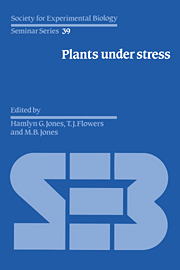Book contents
- Frontmatter
- Contents
- Contributors
- Preface
- 1 Introduction: some terminology and common mechanisms
- 2 The impact of environmental stresses on ecosystems
- 3 Whole-plant responses to stress in natural and agricultural systems
- 4 Photosynthesis and gas exchange
- 5 Regulation of growth and development of plants growing with a restricted supply of water
- 6 Stresses, membranes and cell walls
- 7 Desiccation injury, anhydrobiosis and survival
- 8 Molecular biology: application to studies of stress tolerance
- 9 Environmental control of gene expression and stress proteins in plants
- 10 Plant tissue and protoplast culture: applications to stress physiology and biochemistry
- 11 Breeding methods for drought resistance
- 12 Selection for physiological characters – examples from breeding for salt tolerance
- 13 Prospects for improving crop production in stressful environments
- Index
12 - Selection for physiological characters – examples from breeding for salt tolerance
Published online by Cambridge University Press: 16 March 2010
- Frontmatter
- Contents
- Contributors
- Preface
- 1 Introduction: some terminology and common mechanisms
- 2 The impact of environmental stresses on ecosystems
- 3 Whole-plant responses to stress in natural and agricultural systems
- 4 Photosynthesis and gas exchange
- 5 Regulation of growth and development of plants growing with a restricted supply of water
- 6 Stresses, membranes and cell walls
- 7 Desiccation injury, anhydrobiosis and survival
- 8 Molecular biology: application to studies of stress tolerance
- 9 Environmental control of gene expression and stress proteins in plants
- 10 Plant tissue and protoplast culture: applications to stress physiology and biochemistry
- 11 Breeding methods for drought resistance
- 12 Selection for physiological characters – examples from breeding for salt tolerance
- 13 Prospects for improving crop production in stressful environments
- Index
Summary
Introduction
The areas of land affected by soil salinity are ill defined, because detailed maps are available for few areas only, and consequently global estimates vary widely (Flowers, Hajibagheri & Clipson, 1986). Figures are more reliable for agricultural land in current or recent useage. On this basis some 2 (out of 15) million km2 of land used for crop production is salt affected, and 30–50% of irrigated land (Flowers et al., 1986). This makes salinity a major limitation to food production; indeed it has been recognised as the largest single soil toxicity problem in tropical Asia (Greenland, 1984). Land suited to intensive agriculture is a finite resource, and it has been estimated that the potential for increase is only some 67%, not much more than projected population increases by the end of the century (see Toenniessen, 1984). Dependence upon marginal land, and the need to reclaim land lost already to salinity, appears inevitable. If it is an agricultural necessity to grow plants in saline environments, then there are three possibilities:
1. Change the environment. We are used to solving environmental problems by relatively simple interventions; adding fertilisers, pesticides and water. However, it is much more difficult to remove an excess than it is to supplement a deficiency. A technological solution to the salinity problem has many possibilities but all are costly. In the case of staple foods then either their market value (commercial) or the resources of their consumers (subsistence) precludes such a solution.
2. Improve the resistance of the crop. The overwhelming effort in plant breeding is given over towards what may loosely be termed the ‘improvement of existing crops’.
- Type
- Chapter
- Information
- Plants under StressBiochemistry, Physiology and Ecology and their Application to Plant Improvement, pp. 217 - 234Publisher: Cambridge University PressPrint publication year: 1989
- 32
- Cited by



